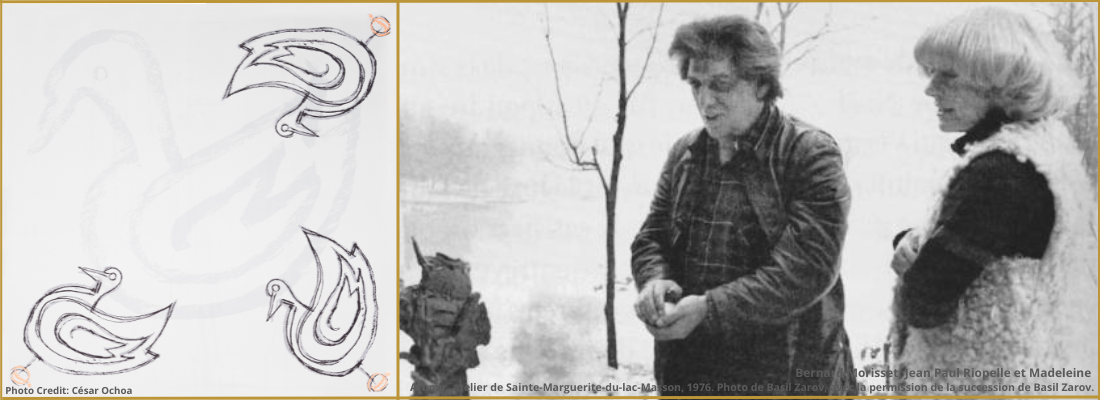Article: Madeleine Arbour and Jean Paul Riopelle

Madeleine Arbour and Jean Paul Riopelle
Biographical notes
The two artists were born the same year, 1923. In the 1940s, they met Paul-Émile Borduas. In 1948, they were both among the sixteen signatories of the Refus global manifesto.
Make way for magic! Make way for love! ... we will joyfully pursue our wild need for liberation.
Madeleine Arbour
She turned 100 in 2023. She is the “grande dame” of design, scenography, television and the visual arts, honored as such by UQAM, which awarded her an honorary doctorate in 2012.
In the 1940s, as a young window dresser, she created surrealistic window displays for the Birks jewelry store in Montreal. This was followed by a series of projects for theater and television: sets, crafts and costumes. She taught the art of window-dressing, created tapestries and murals, and, above all, spread the art of living: beauty emerges in the spaces she designed, whether the office of Prime Minister P. E. Trudeau or Via Rail carriages.
 Madeleine Arbour, 1984. Photo de Jean Goupil, avec la permission de La Presse. L’oeuvre est tirée des fonds d’archives et collections de Bibliothèque et Archives nationales du Québec.
Madeleine Arbour, 1984. Photo de Jean Goupil, avec la permission de La Presse. L’oeuvre est tirée des fonds d’archives et collections de Bibliothèque et Archives nationales du Québec.
Jean Paul Riopelle
He would have been 100 in 2023. Painter, sculptor, multidisciplinary artist, he used all techniques and materials. A prolific artist, he is credited with nearly 7,000 works.
In 1943, as a student at the École du meuble, he befriended Borduas. In 1947, he moved to Paris, where a remarkable career awaited him: in the 1950s, he experienced a period of intense creativity, producing his great mosaics, paintings in which colors exploded, making him one of the great exponents of lyrical abstraction.
Towards the end of the 1950s and into the 1960s, Riopelle turned to sculpture and engraving. He then returned to figuration, with imagery inspired by the far north.
Jean Paul Riopelle died in L'Isle-aux-Grues on March 12, 2002.
 Riopelle à l'atelier de Sainte-Marguerite-du-Lac Masson, 1977. Photo de Basil Zarov, avec la permission de la succession de Basil Zarov.
Riopelle à l'atelier de Sainte-Marguerite-du-Lac Masson, 1977. Photo de Basil Zarov, avec la permission de la succession de Basil Zarov.
A creative friendship
Riopelle called Madeleine Arbour his sister. Their friendship lasted a lifetime.
With mischievous delight, she often recounted how the two would steal roosters from steeples to keep them out of the hands of American antique dealers.
Madeleine Arbour's long stays at his Lac Masson studio in the late 1970s also speak of this friendship: she came there to take advantage of the Laurentian light to devote herself to tapestry. A studio she also designed for Riopelle.
In 1990, Madeleine Arbour presented her friend with a magnificent cabinet of curiosities, a work entitled Boîte anniversaire pour Riopelle, which she created from objects found at the artist's parents' home.
And in 1994, at the request of his friend Madeleine, Riopelle agreed to sign a silk square, the Canard à l’orange, for the Musée du Québec.
A silk square signed by Riopelle
Riopelle never chose between the chic and the casual, drawing on the somewhat insolent freedom that makes great artists. Thus, in 1994, he illustrated and signed Le Canard à l'orange for the Musée du Québec, a high-end silk square, an art and fashion object designed by the famous designer, his friend Madeleine Arbour.
Today, the Jean Paul Riopelle Foundation, in an unprecedented partnership with Quebec designer Nathon Kong, is offering a new series of this exceptional collector's item, in a luxury edition numbered and limited to 100 copies, produced under the direction of Yseult Riopelle, director of Le Catalogue raisonné de Jean Paul Riopelle.
A short history of Canard à l’orange
There's nothing accidental about the motif Riopelle imagined in 1994 to illustrate his silk scarf: the aquatic bird is in fact the Canard à l'orange, the emblem chosen by Riopelle for the flag of the captain (Riopelle himself...) of the Serica, the sailboat the artist acquired from gallery owner Pierre Matisse. The drawing is reproduced in the three corners and center of the silk scarf, in shades of black, gray and orange on an off-white background. The Canard à l'orange inaugurated beautifully the magnificent Collection des beaux-arts of the Musée du Québec (now Musée national des beaux-arts du Québec) which features high-end fashion objects and accessories inspired by the works of the museum’s artists.

Photo Credit: César Ochoa
Le Canard à l’orange reedited
Reedited by the Riopelle Foundation and Nathon Kong in this year of Riopelle's centenary, the Canard à l'orange offered today is a tribute to art and creators. It has lost none of the chic and casualness of its origins, summed up at the time in a text from the Musée du Québec.
Print on silk
Limited edition prints on silk of Canard à l'orange
- Hand-sewn by artisans
- Fine art print on 100% mulberry silk
- Limited edition, only 100 reproductions, signed by Riopelle's daughter, Yseult Riopelle.
- Dimensions of work: 52 inches x 52 inches / 132 centimeters x 132 centimeters.
A portion of the proceeds is donated to the Foundation Riopelle, a non-profit organization supporting youth education programs.




Leave a comment
This site is protected by hCaptcha and the hCaptcha Privacy Policy and Terms of Service apply.